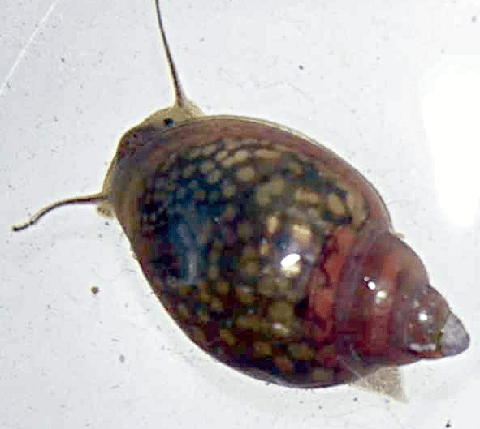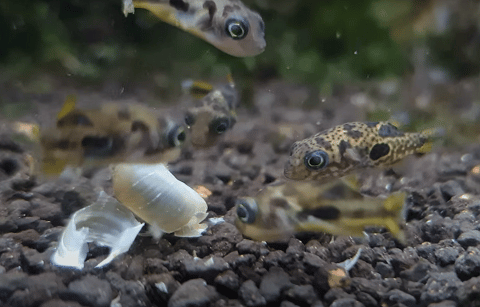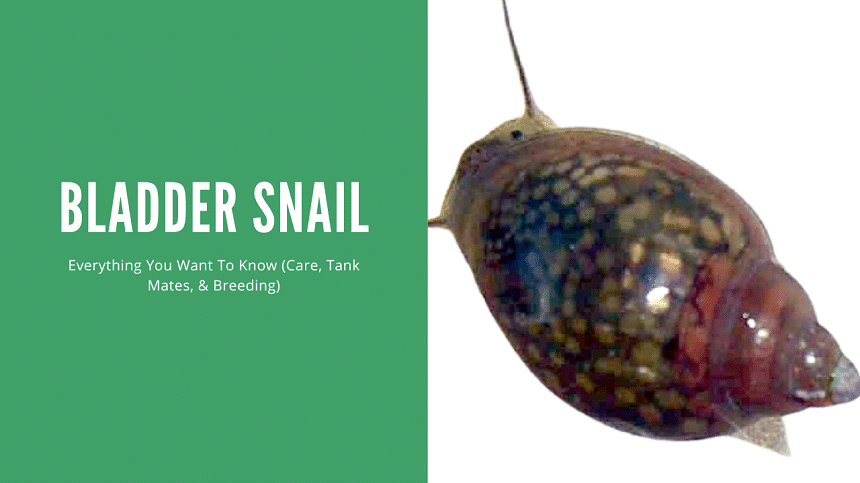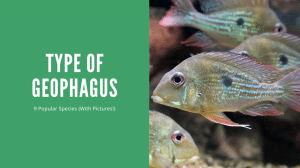Thank you for visiting! By the way… any links on this page that lead to products on Amazon and other stores/partners are affiliate links Aquarium Store Depot earns a commission if you make a purchase.
Have you ever thought about bringing a Bladder Snail into your aquarium (Or have them living in your tank accidentally)? They have a mixed reputation – to some they are pests and to others they are helpful clean up crew members. Today’s post is to learn about how easy it is to look after them, manage their numbers, and guarantee they thrive in your home-based habitat.
Key Takeaways
- Bladder snails are adaptable, have unique respiratory systems and help keep aquariums clean.
- They’re small & colorful with yellowish-orange spots and a sinistral shell.
- The bladder snail is known for overpopulation a tank and will be seen as a pest by many fish tank owners
- To ensure their well being, provide the bladder snail with a diverse diet, maintain tank conditions & introduce natural predators to control population growth.
Species Overview
| Scientific Name | Physella acuta |
| Common Names | Bladder Snail, Acute Bladder Snail, Pond Snail (mistakenly) |
| Family | Physidae |
| Origin | Originally from Europe, but now widely distributed globally |
| Diet | Herbivorous |
| Care Level | Easy |
| Activity | Mostly active during the night (nocturnal) |
| Life Span | 1-2 years |
| Temperament | Peaceful |
| Tank Level | All levels |
| Minimum Tank Size | 10 gallons |
| Temperature Range | 65-82°F (18-28°C) |
| Water Hardness | 2-15 dKH |
| pH Range | 7.0-8.0 |
| Filtration/Water Flow | Any |
| Water Type | Freshwater Tanks |
| Breeding | Asexual or Sexual – Egg Layer |
| Difficulty to Breed | Easy |
| Compatibility | Community Tanks |
| OK, for Planted Tanks? | Yes |
Understanding Bladder Snails
The Bladder snail is found in freshwater locations all over the world except Antarctica. The bladder snail’s incredible adaptability is due to a special respiratory system allowing them to float and swim around. This makes for an ideal addition to any aquarium since they consume algae and other waste keeping it clean while having quite a bit of resilience.
These freshwater snails usually get into home tanks through hitchhiking rides on plants or decorations entering from driftwood, leaves, rocks, etc. Despite this being able bodied species, they can become invasive when not managed properly in some areas making understanding how you care for them even more important than ever before as bladder snails provide amazing benefits if handled correctly!
Natural Habitat
Bladder snails (often called pond snails) can be found virtually worldwide, with the exception of Antarctica. They have been discovered in ponds, streams, rivers and lakes, as well as irrigation systems such as rice fields or ditches, even municipal drains! This adaptability has led to fears that they might spread uncontrollably if not managed carefully – thus making it critical to limit their population growth through aquariums and other artificially regulated settings.
Appearance

Bladder snails possess a sinistral shell without an operculum, having yellowish-orange spots on their mantle and thin tentacles with small black eyes. Their size is small. Restricted to 0.6 inches or smaller in length. You can differentiate them from pond snails by the shape and color of their shells. They are equipped with little feet which allow for mobility across your aquarium. Providing fun entertainment during observation of them scuttling around!
Comparing With Pond Snails
When it comes to looks and adaptability, bladder snails are more remarkable looking than pond snail counterparts. There are a few differences:
- They appear in a range of vibrant colors while being more capable of withstanding varying water temperatures as compared to the latter (making them more hardy than the pond snail).
- Pond snails are usually bigger – about 2-3 times larger
- Their shell spinal are to the left, otherwise known as sinistral. Pond snails shells sping to the right
- The bladder snails lack a operculum lid to protect itself
Behavior & Adaptability
When danger is detected, bladder snails react in a unique manner. They shake their bodies and swim rapidly to the bottom of the tank for protection using air from their pulmonary cavity. This action helps them expel any parasites or microbes that may be present on their body too.
Their respiratory system plays an essential role when it comes to survival as well. Not only does it provide necessary oxygen, but also enables them to move quickly away from potential predators or dangers present in the environment they live in. The presence of an air bladder within this species gives even more agility during such times, giving these animals better chances at evading threats successfully by fleeing through waters swiftly towards safety.
Movement & Defense Mechanisms
Bladder snails showcase their agility by being able to quickly move around the water using just their feet, and even can swim upside down at the surface for breathing air. When facing a predator, they display resourcefulness in defense with an impressive movement of flipping back and forth between inside and outside of its shell rapidly (video source).
Adapting to Tank Conditions
Bladder snails are excellent for new aquarists, as they require little effort to maintain and can tolerate a variety of water parameters. Their impressive adaptability means that bladder snails will thrive in diverse tank conditions, from temperature and pH levels to hardness. They are incredibly hardy animals which makes them a great option when it comes to a clean up crew, and they will help with consuming fish waste.
Diet & Feeding Habits
Bladder snails are omnivores, meaning they will feast on whatever is available in an aquarium, such as algae and decaying waste. To prevent overpopulation due to excessive feeding, moderation must be practiced when offering food. Along with a diverse diet that could include eggshells or cuttlefish bones for calcium-rich nutrients, bladder snails require other items like algae wafers and blanched vegetables (as well as sinking pellets) to stay healthy in their environment. Monitoring the balance of dietary intakes helps keep these bladder snails happy too!
Preferred Food Sources
Bladder snails should consume a variety of foods to stay healthy and grow, such as decaying plant matter, biofilm, algae, insects, veggies and meat. They will scavage edibles meant for fish if given the opportunity. Supplying an assorted diet (and plenty of algae) that includes all the needed nutrients will keep bladder snails in good health condition.
Impact on Aquarium Plants

It is a common misconception that Bladder snails eat plants. In actuality, these snails will not consume live lives in freshwater tanks. Their man issue is the rare they reproduce at.
Bladder snails are beneficial to have in your aquarium, as they eat any decaying plant matter and detritus present. This helps keep the tank clean without threatening healthy plants. As long as your flora is doing well, these little critters will be a welcome addition for keeping an orderly environment underwater.
Creating a Suitable Environment
Bladder snails can survive in a freshwater tank of any size due to their adaptability, although it is recommended that larger ones are kept for maintenance purposes. They don’t necessarily require live plants or hiding spots as they prefer warm, still waters and the main factor involved in creating a good environment for them should be cleanliness.
This entails regular water changes and proper filtration which will help maintain an ideal balance between temperatures ranging from 64-84 Fahrenheit with pH 7-8 degrees of hardness so ammonia/nitrate levels remain safe. This helps guarantee bladder snails live a healthly life along with other aquatic life within their habitat too!
Tank Size & Setup
When keeping bladder snails, it is necessary to have an aquarium of at least 10 gallons. The water temperature should be maintained between 65 and 75 degrees Fahrenheit for the optimum health of your creatures. Creating such conditions will keep them active and in good shape.
Water Parameters & Calcium Needs
The well-being and longevity of bladder snails depend on having the right water conditions, such as warm temperatures with little to no current. For them to have healthy shells and for their growth and reproduction, it is essential that calcium-rich sources are available. These may include cuttlefish bones or eggshells. Maintaining appropriate water parameters should be a priority in order to ensure your bladdersnail’s health.
Breeding & Population Control
Bladder snails reproduce asexually when there isn’t an available mate. This is accomplished by self-fertilization due to their male and female reproductive organs. This will occur if the population of them is threatened. Due to their ability for rapid reproduction, it can be difficult managing population levels within an aquarium environment.
To combat this problem, one should pay close attention to how much food they are consuming, as too much will lead quickly towards overpopulation issues. Some methods which may aid in keeping populations under control include housing them alongside natural predators or by trapping existing snails out of the tank periodically, all effective measures that help create balance when caring for these creatures properly.
Reproduction Methods
Mating for bladder snails can be a lengthy process that involves each individual climbing onto the other’s shell and covering their partner’s reproductive organs. The egg capsules of these creatures may contain between 10 to 50 eggs, with hatching occurring in around 6-7 days.

When they emerge from the capsule, baby bladder snails are very small, typically just 1mm long! These baby bladder snails will reach maturity in as little as one month!
Controlling Population Growth
In order to manage the bladder snail population, consider introducing natural predators into your tank such as loaches, puffers and assassin snails. Be aware that excess food given to fish can also contribute towards an increase in their numbers. Thus it is important you only give them what they need for growth. Regular water changes are likewise necessary so as not to let the snail population get out of control, manual removal may even be required at times too!
It is also something to note that the bladder snail is equipped with a sperm storage organ. Even if one makes it into your aquarium, the bladder snail can use this organ to reproduce. This is similar to female livebearers, who are able to store sperm for several months.
By utilizing these strategies correctly, a balanced ecosystem will undoubtedly follow suit within your aquarium habitat.
Tank Mates & Predators
Bladder snails can form a beneficial addition to an aquatic setting due to their versatility and ability of coexisting with other freshwater creatures. To ensure that the population does not become out-of-hand, it may be wise to house them alongside fish like betta fish which eat bladder snails in order maintain balance inside your tank ecosystem.
Compatible Tank Mates
Bladder snails are safe to live alongside:
- Shrimp
- Small fish
- Other snails like the nerite and mystery snails
It is best not to cohabit these aquatic snails with aggressive types such as crayfish, yoyo loaches, betta fish or puffers – which could cause harm to the bladder snail’s wellbeing (unless you want to reduce their population — more on that below).
Natural Predators

Bladder snails have a few natural predators, including:
- Carnivorous fish
- Assassin snails
- Crayfish
- Loaches
- Freshwater puffers
These creatures can reduce the number of bladder snail populations while also maintaining balance in aquariums. Crayfish are likely to feast on softer and smaller specimens, whereas assassin snails tend to feed on adult and baby snails. Housing these creatures with their predators will help bring down their numbers accordingly.
Health & Disease Prevention
Bladder snails can remain in excellent health if their environment is kept optimal. By regularly monitoring the water parameters and making necessary adjustments to maintain steady conditions within the tank, bladder snail owners are helping ensure that these creatures stay healthy and thriving. It is also important for them to have access to a nutritious diet with items such as algae wafers, blanched vegetables or sinking pellets.
This will provide essential nutrients which help promote good growth of shells of your bladder snails while preventing potential digestive issues like indigestion from occurring. An effective way of maintaining hygiene is through regular water changes so their habitat remains clean at all times – something proven vital when it comes sustaining strong calcium-rich shells & successful reproduction rates!
Common Health Concerns
Healthy bladder snails can be affected by a few common ailments, including bacterial and fungal infections and damage to their shells. Shell help is a common aliment if your calcium levels stay long. Parasites are usually less of a worry since the bladder snail has this cool ability to remove bugs and parasites away with its unique respiratory system. These aquatic snails were built to be tough!
Preventative Measures
Maintaining a clean, hygienic environment and regularly changing the water are essential steps to preventing diseases in bladder snails. Providing them with varied nutrition that is rich in calcium can also help keep them healthy and strong. By following these tips you will greatly increase the chances of keeping them around (then probably worrying about how many they are afterward)!
Frequently Asked Questions
Are bladder snails bad for your tank?
Bladder snails, in general, are harmless and can even be beneficial to your tank. They will not cause any damage to other fish or plants. Instead they help by eating leftover food scraps that would otherwise decompose at the bottom of your tank. It is essential to ensure their population doesn’t exceed a certain size as too many bladder snails may overrun the aquarium environment if there’s too much extra food being supplied into it.
Is the bladder snail invasive?
It is advisable to be cautious when bringing in plants and animals into an aquarium since bladder snails (Physa acuta) can become a problem. They are considered invasive species because of their tendency for quick proliferation. This makes them hard to eliminate from any water container once established.
Thus, taking steps beforehand may help avoid adding these creatures which could cause complications later on if allowed to thrive unchecked.
What is the benefit of bladder snail?
The Physella acuta, commonly known as the Bladder Snail, is a great addition to any aquarium. Not only does it scour the substrate and feast on algae growths, but also doesn’t touch or consume your aquatic plants!
What’s more? They are incredibly hardy animals that can easily enter an aquarium by hitting rides with live plants – so you don’t even need to make deliberate efforts of introducing them into your system. All in all, when considering cleanup crew options, Bladder Snails should be high up on anyone’s list!
Will bladder snails eat live plants?
Contrary to what some may think, bladder snails will not feed on any living plant matter, a trait which sets them apart from pond snails. Thus it can be confidently stated that these particular species of mollusks consume no vegetation at all.
Are bladder snails bad for your tank?
Bladder snails can be a boon or a bane to your aquarium based on the situation. They bring huge benefits in terms of waste management and reducing algae, so long as they don’t end up taking over due to unchecked growth. It is necessary for their numbers to remain regulated if you want them around. Otherwise it will become too chaotic!
Closing Thoughts
Bladder snails can be a beneficial “accidental” addition to any fish tank, as they help maintain a clean tank. However, they are known for reproducing like crazy, so understanding how to keep their numbers down is helpful if you are planning to keep them around.
Taking care to ensure the right environment and keeping your bladder snails population in check will result in a thriving population that brings life into your tank if you want to enjoy all the benefits these resilient creatures offer fully, be sure to give them proper attention (and monitoring) they require!
- About the Author
- Latest Posts
I’m thrilled that you found Aquarium Store Depot! Here you’ll find information on fish, aquariums, and all things aquatics related. I’m a hobbyist (being doing this since I was 11) and here to help other hobbyists thrive with their aquariums! I adhere to a high quality Editorial Process and Review products with real life field usage and practical analysis.





